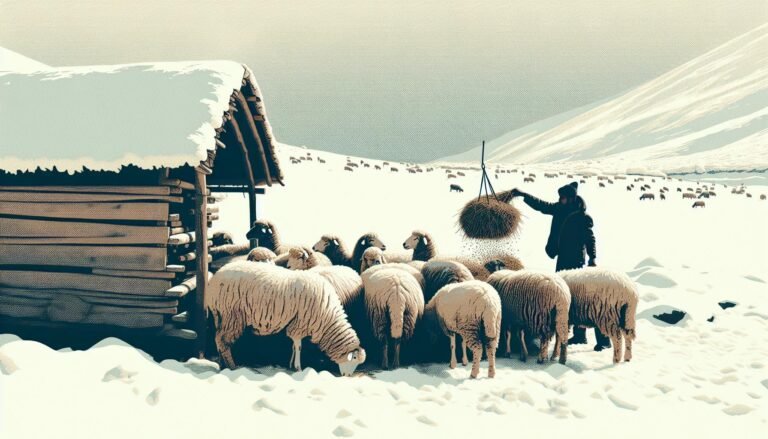Mastering Sheep Hoof Trimming: techniques, mistakes to avoid, and tips for success
If you’re a sheep owner, you’ll know that hoof care is an essential part of your routine. It’s not just about keeping your flock looking good, it’s about their health. Overgrown hooves can lead to a host of problems, from difficulty walking to serious infections.
But don’t worry, I’m here to help. Over the years, I’ve honed my skills and I’m ready to share my knowledge on how to trim sheep hooves effectively and safely. Whether you’re a seasoned shepherd or a newbie, this guide’s got you covered.
Key Takeaways
- Trimming sheep hooves is vital for their health and productivity. Overgrown hooves can cause walking difficulties, infections, and even lameness, affecting the sheep’s overall well-being. Regular hoof trimming aids in maintaining cleanliness, decreasing the chance for bacterial and parasitic growth.
- Having the right instruments is essential for effectively and safely trimming sheep hooves. Key tools include hoof trimmers, a hoof pick, a hoof knife, and protective gear for the caregiver. Optional accessories like a hoof rasp or a hoof stand can enhance the trimming experience.
- Proper preparation prior to trimming ensures a stress-free and safe process. The environment should be clean, well-lit, and dry. The sheep should be calm and fasted for about 12 hours before the procedure. A preliminary hoof check for any cuts, sores, or signs of foot rot is also crucial.
- The trimming process includes securing the sheep, cleaning and inspecting the hooves, trimming from the hoof tip back towards the heel, and finally smoothing the hooves with a hoof rasp. It’s important to work carefully to avoid cutting into the quick, which can cause pain and bleeding.
- Common mistakes to avoid include cutting into the quick, neglecting regular inspections, rushing the process, and improperly holding the hoof. Each of these mistakes can cause discomfort to the sheep, jeopardize the trimming process, and potentially lead to infections.
- Tips for successful hoof trimming include regular inspections, not rushing the process, ensuring the sheep’s comfort, and focusing on health over appearances. Remember, the goal is a healthy hoof, not a perfectly trimmed one.
Why Trimming Sheep Hooves Is Important
You’re already aware that trimming sheep hooves is necessary. But do you really grasp why it’s essential? As an expert in sheep care with years of hands-on experience, I’d like to shed some light on the critical reasons behind this vital routine.
Firstly, hoof health directly affects the overall wellness of your flock. Overgrown hooves are more than just unsightly – they’re a potential health hazard. Untrimmed hooves can lead to abnormal gait patterns, the formation of painful foot sores, and even lameness. Over time, the pain may cause the sheep to eat less and lose weight, affecting its productivity and overall health.
What’s more, hoof-related health issues can cost you both figuratively and literally. You’ll find yourself dedicating more time, energy, and even medicines to managing discomfort and disease among your flock. A preventative approach not only does wonders for the sheep’s health but also for your peace of mind and finances.
In addition to the health implications, regular hoof trimming is integral in maintaining the cleanliness of your flock. Overgrown hooves may captivate mud and manure, encouraging the growth and spread of harmful bacteria and parasites. Thus, by keeping the hooves trimmed, you’re also reducing the opportunity for parasite infestation.
Finally, let’s not overlook the role that well-maintained hooves play in a sheep’s contentment. A healthy, pain-free flock is apt to be happy, active, and productive—a win-win for both of us!
Indeed, sheep hoof trimming is a non-negotiable aspect of successful and ethical sheep rearing. So now we’ve highlighted the reasons, let’s dive deeper into how it’s done. Trust me—once you make hoof-trimming a regular part of your flock management, you’ll begin noticing the robust benefits it yields. Next, we discuss the tools and techniques you’ll need for effective hoof trimming.
Tools You’ll Need
Whether you’re an experienced shepherd or just starting out, having the right tools for the job is half the battle won. Specially designed equipment simplifies the process and ensures the job gets done correctly. Here’s a rundown of the primary tools you’ll need for trimming sheep hooves.
Hoof Trimmers
Undoubtedly, the most indispensable tool for this job is a good pair of hoof trimmers. Built to meet the challenges of cutting through tough sheep hoof material, these trimmers fit into the hand comfortably, providinga good grip. Some choose straight-edged trimmers while others swear by the serrated pair – it solely depends on your preference and the hardness of the hooves you’re dealing with.
Hoof Pick
Another key instrument in your toolkit should be a hoof pick. This device aids in removing stones, dirt and debris lodged in the hoof ’ groove, preparing it for a more precise trim. Having an ergonomic and sturdy hoof pick ensures your sheep’s hooves are clean and ready for trimming.
Hoof Knife
Adding a hoof knife to your collection helps scrape off the layers of the hoof that are difficult to reach with trimmers alone. Resembling a pocket knife, its curved blade is perfect for removing soles and tidying loose flaps on the hoof.
Protective Gear
Aside from these crucial tools, don’t forget to gear up with safety equipment. A sturdy pair of gloves can prevent potential hand injuries during the trimming process. Additionally, safety glasses are a great addition to prevent dust or splinters from getting into your eyes.
Additional Accessories
While not absolutely necessary, extra accessories like a hoof rasp or a hoof stand can add ease and convenience to the entire process. A hoof rasp is used for smoothing out rough edges, while a hoof stand can support the weight of the sheep’s leg making the trimming process much easier.
In the table below, I’ve provided a for your reference:
| Tool | Purpose |
|---|---|
| Hoof Trimmers | Cutting hoof material |
| Hoof Pick | Removing dirt/debris |
| Hoof Knife | Scraping off tough layers |
| Protective Gear (Gloves, Glasses) | Safety during trimming |
| Hoof Rasp (Optional) | Smoothing rough edges |
| Hoof Stand (Optional) | Supporting the sheep’s leg |
Preparing the Sheep for Hoof Trimming
Before beginning the hoof trimming process, it’s vital to prepare your sheep adequately. Proper preparation not only eases the process but also minimizes stress on the animal. So, how’s this preparation done, you ask? Well, let’s dive right into it.
Preparing your sheep starts with a check on the environment. It’s essential to perform the trimming in a clean, well-lit, and dry area. This reduces the risk of introducing new infections during the process. Keeping the place dry minimizes chances of slips or falls, both for you and the sheep.
Moving on to the sheep, ensure they are calm and relaxed prior to the procedure. This could be achieved by perhaps talking softly to them or brushing their wool. You don’t want a skittish sheep on your hands while wielding sharp tools.
Let’s talk a bit about fasting. It’s recommended to fast the sheep for about 12 hours before hoof trimming. Reducing rumen volume makes it easier for the sheep to be turned and held on its side for the procedure. Just remember to provide access to water to keep the animal hydrated.
Lastly, perform a preliminary check on the sheep’s hooves. It’s important to identify any cuts, sores, or signs of foot rot. If any of these are found, consider consulting a vet before proceeding.
Preparing the sheep for hoof trimming is an essential step that ensures a safe and effective procedure. A clean environment, calm sheep, a 12-hour fasting period, and a preliminary hoof check form the basis of this preparation.
Remember that hoof trimming is not just a task, but an integral part of your flock’s health management. So, take your time and do it right. Your sheep will thank you for it.
Step-By-Step Guide to Trimming Sheep Hooves
Notably, successful hoof trimming is all about technique and precision. Let’s dive right in.
Step 1: Secure the Sheep
First, you’ll need to secure the sheep. Position the sheep on its rear, securely held between your knees. This technique is known as “turning the sheep on its rump”, and it makes hoof access much easier.
Step 2: Clean the Hooves
Once you’ve got your sheep securely positioned, it’s time to clean the hooves. Use a hoof pick for this task. Gently pick away at any hardened mud, pebbles, or dung that might be stuck in the hoof’s crevices.
Step 3: Inspect the Hooves
After cleaning, give the hooves a good look-over. You’re checking for anything abnormal, like cuts, sores, or signs of foot rot. Any issues detected at this point should be dealt with before proceeding to the next step.
Step 4: Start Trimming
Now you’re ready to trim! Start at the tip of the hoof, working back towards the heel. Your aim is to achieve a flat, even surface that aligns with the natural shape of the hoof. Be careful to trim little by little, avoiding the quick (pink tissue inside the hoof). Cutting into this can cause pain and bleeding.
Step 5: Smooth the Hooves
Once all hooves are trimmed, finish up by smoothing them with a hoof rasp. This removes any rough edges, reducing the risk of injury or discomfort for your sheep.
Remember, practice makes perfect. It’s important not to rush, especially if you’re new to this. Never treat hoof trimming as a race against the clock – you’re aiming for quality, not quantity. As you gain experience, you’ll find that your speed naturally improves.
Now that you’ve got a solid understanding of the steps involved in trimming sheep’s hooves, let’s delve into a few tips and tricks I’ve picked up over the years…
Common Mistakes to Avoid
As you start trimming sheep hooves, you’re bound to make a few mistakes. It’s all part of the learning curve. But there are some common errors I’d like to help you avoid in order to ensure your flock maintains optimal hoof health.
First off, avoid cutting into the quick. This is the live, sensitive part of the hoof that bleeds when nicked. It’s not only painful for the sheep, but it also increases the risk of infection. Always take a conservative approach when trimming, cutting away small amounts at a time. If you’re unsure, it’s better to trim less rather than more.
Next, don’t neglect regular inspections. This can lead to missed signs of foot rot, cuts or sores which could further jeopardize the health of the sheep. Remember, a clean and health-checked hoof is the best starting point for trimming. Regular inspections also provide an opportunity to assess the growth rate of hooves and to plan the trimming schedule accordingly.
This is vital: Don’t rush the process. While it’s important to be efficient, quality should be your focus. Swift, haphazard trimming can result in uneven hooves which cause discomfort and potentially contribute to lameness in your sheep. Take your time – precision is key.
Lastly, something as simple as holding the hoof incorrectly can cause problems. Always secure the sheep properly and hold the hoof in the right position. If the sheep is off-balance or uncomfortable, they’ll likely squirm and play a game of wrestling with you. A secure, comfortable grip ensures a smooth and safe trimming process.
Tips for Success
While the nuts and bolts of trimming sheep hooves are crucial, I’ve found there are certain tips that will put you miles ahead of the flock with regards to hoof health. These tips aren’t merely about the technical process, but extend into forming good habits, knowing what to look for, and understanding the underlying structure of the hoof.
A good starting point is to prioritize regular inspections. Just like us, sheep can have good and bad hoof days. Regular checks allow you to notice subtle changes, detect early signs of potential problems, and take timely action. With my flock, I’ve found that an inspection every six to eight weeks catches most issues before they escalate.
Do you remember the first time you trimmed sheep hooves? I sure do – it was daunting, and the temptation to rush through the job was almost overwhelming. But heed my warning: don’t rush the process. It’s all too easy to make a misstep, especially when the sheep are restive. Taking your time ensures you have the opportunity to assess the hoof properly and avoid making cuts that could harm the animal.
Next, pay attention to the sheep’s comfort. An uncomfortable sheep is a stressed sheep, and this increases the risk of injury to both you and the animal. A secure grip is vital, but here’s a tip: focus on keeping the sheep balanced and secure, rather than just restraining them forcefully. I still recall a wise old shepherd’s advice to me, “the more a sheep fights, the more likely you’ll cut too deep.”
Then there’s the old saying handed down from shepherd to shepherd, “Never cut too close to the quick.” This is an area of soft tissue found inside the hoof. If you happen to nick this area, it leads to discomfort for the sheep and potential infection.
Take a breath, stay calm, and remember: the goal is not to create a perfect-looking hoof, but a healthy one.
Conclusion
So there you have it. Trimming sheep hooves doesn’t have to be a daunting task if you follow the right steps and avoid common pitfalls. It’s all about precision, patience, and putting your sheep’s comfort first. Remember, the aim isn’t to achieve a perfect-looking hoof but a healthy one. Regular inspections and a conservative trimming approach are your best allies in this process. Don’t rush, hold the hoof correctly, and avoid cutting into the quick. With these tips in mind, you’re well on your way to mastering the art of sheep hoof trimming. Trust me, your sheep will thank you!







